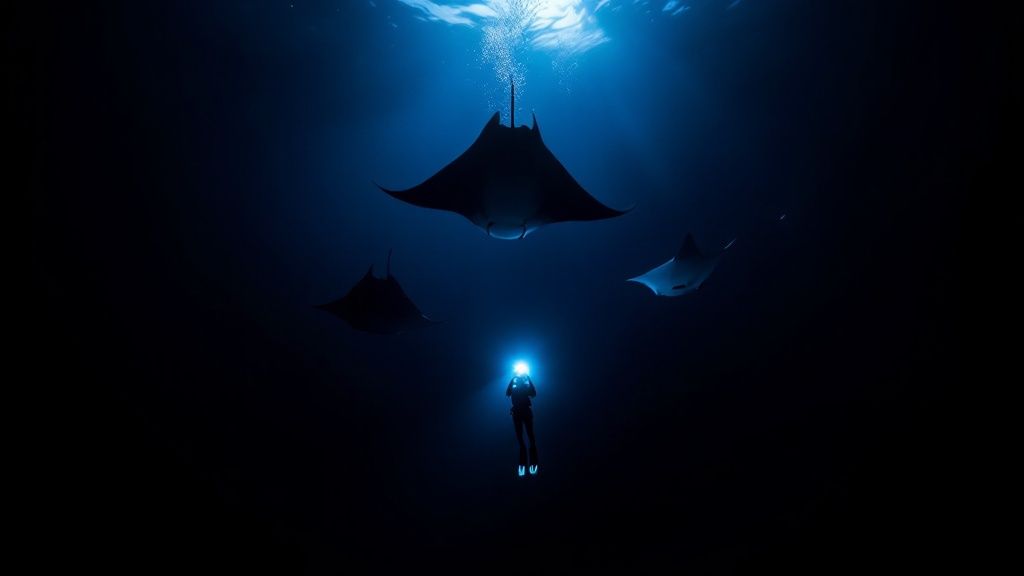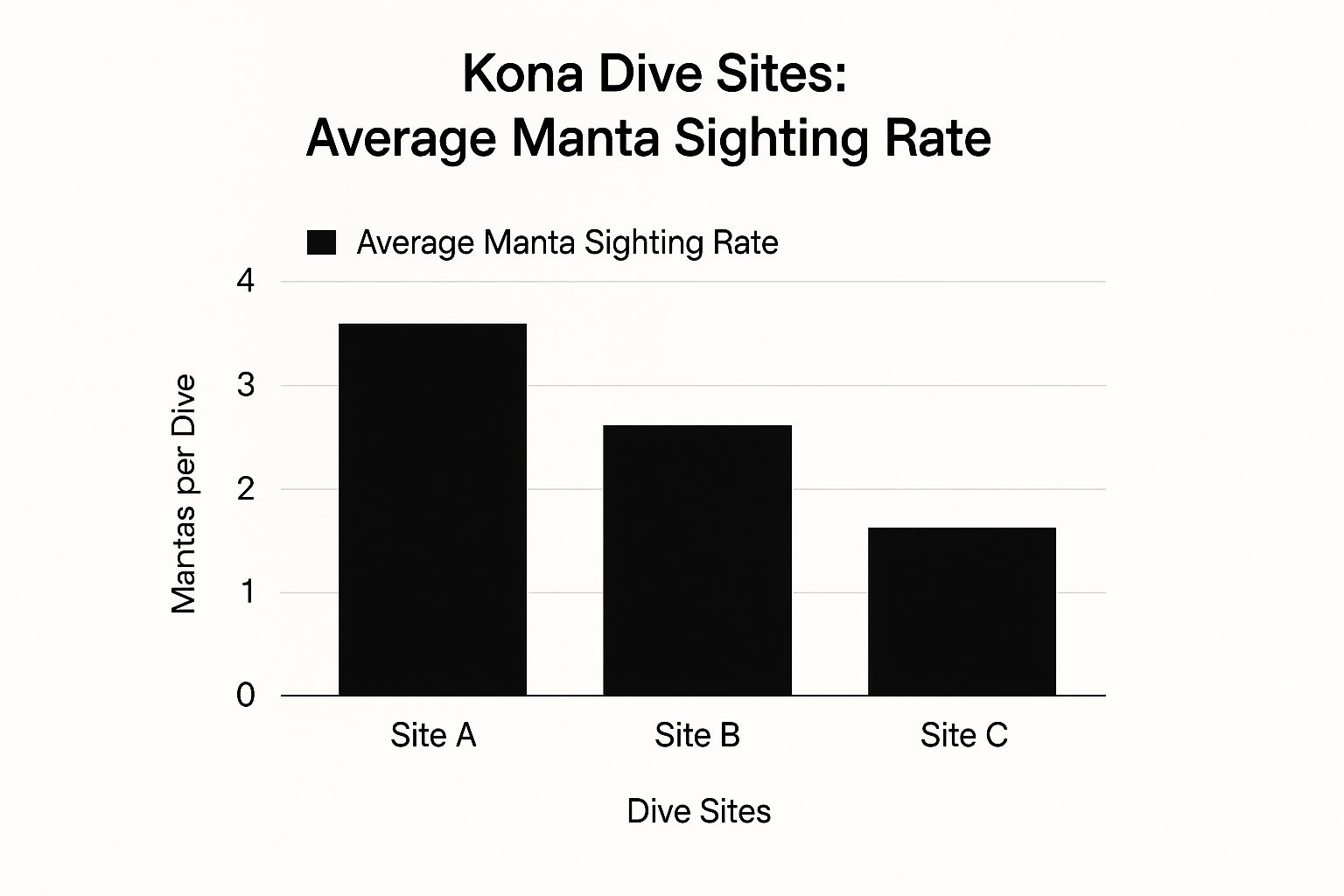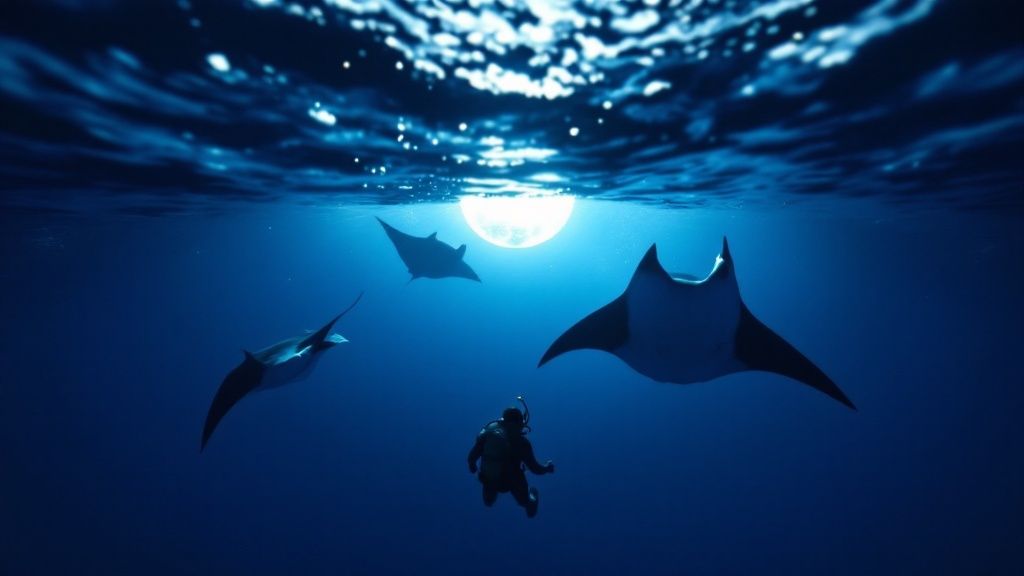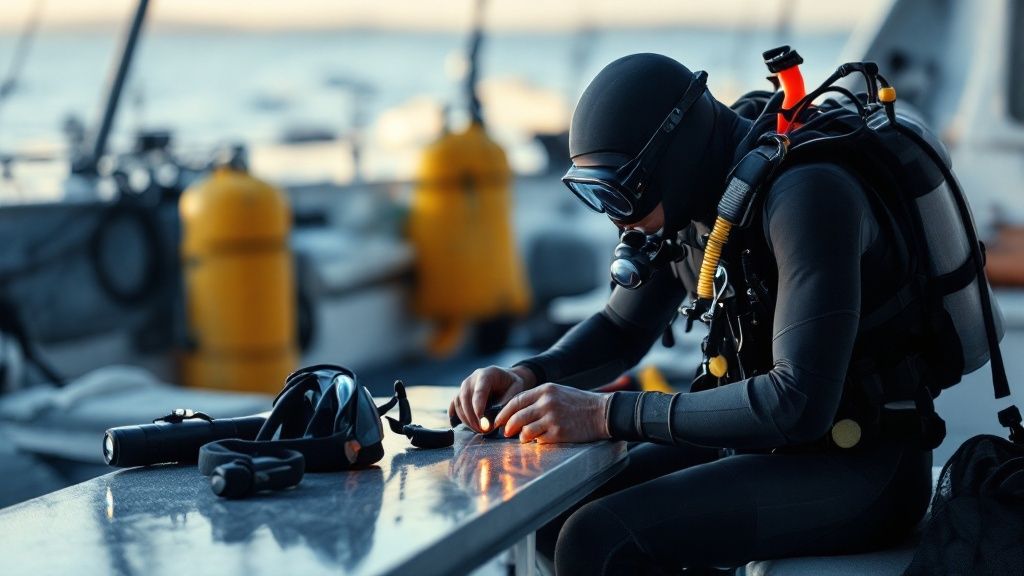Why Manta Dive Kona Creates Life-Changing Encounters
Kona, Hawaii, isn't just a beautiful vacation destination; it's a global hotspot for manta ray encounters. What makes a manta dive in Kona so special? It's the unique combination of ecological factors creating a perfect feeding ground for these gentle giants. These factors, coupled with the expertise of local dive operators, transform a simple dive into a truly memorable experience.
The Perfect Blend of Nature's Ingredients
The shallow, clear waters off the Kona coast, typically between 30 and 40 feet deep, offer incredible visibility. Divers and snorkelers get unparalleled views of these majestic creatures. The optimal depth allows ample sunlight to penetrate, encouraging the growth of phytoplankton, the base of the manta ray's diet. The unique underwater topography, with gentle slopes and volcanic formations, creates ideal currents that concentrate plankton. This sets the stage for a nightly feeding spectacle. Areas like Manta Village and Manta Heaven are renowned for their high plankton concentrations, attracting mantas in droves.
Kona's Remarkable Sighting Success Rates
The abundant plankton, coupled with the strategic use of dive lights, is an irresistible draw for manta rays. The lights attract even more plankton, creating a feast for the mantas. This predictability sets Kona apart. The Kona Coast is renowned for its consistent manta ray sightings, with an average success rate of 85-90% for many operators. Some even report rates exceeding 95%. This high success rate is thanks to the unique ecological conditions, including the shallow waters and plentiful plankton attracted by dive lights. This makes the Kona coast one of the most reliable places globally for manta ray dives. Find more detailed statistics here
From First-Timers to Passionate Return Divers
The combination of shallow, clear water, abundant food, and the mesmerizing dance of feeding mantas creates an unforgettable experience. It's not just seeing the mantas; it's feeling immersed in their world. Imagine witnessing these graceful creatures, with wingspans reaching up to 18 feet, performing acrobatic flips and turns just inches away. This intimate interaction fosters a deep connection with the marine environment, often sparking a lifelong passion for ocean conservation. First-time visitors often become passionate advocates for manta ray protection, returning year after year. You might be interested in: Why should you go on a manta ray dive in Kona?

The "Manta Guarantee": A Testament to Kona's Unique Ecosystem
Some operators even offer a "manta guarantee," a testament to Kona’s unique ecosystem and the predictability of these encounters. This commitment underscores the reliability of manta sightings, solidifying Kona's reputation as a premier destination for manta ray dives worldwide. The experience is truly special and often described as life-changing, transforming casual observers into passionate ocean advocates.
Planning Your Perfect Manta Dive Kona Adventure
Planning a manta ray dive in Kona, Hawaii, is an exciting endeavor. It's more than just booking a flight; it's about crafting an unforgettable experience with these gentle giants. This involves careful consideration of several factors, from the time of year to the tour operator you choose, and even understanding the nuances of the different dive options available.
Choosing the Right Season for Optimal Visibility and Manta Activity
Manta rays grace the waters of Kona throughout the year. However, certain seasons offer more favorable conditions for viewing. Don't rely solely on glossy brochures; delve deeper into long-term sighting records and seek advice from local experts. These resources provide a more realistic picture of the optimal viewing conditions. For example, the summer months (June-August) generally offer calmer seas and excellent visibility. The winter months (December-February) can experience plankton blooms, attracting larger numbers of mantas. Each season offers unique advantages, so research thoroughly and select the one that best suits your preferences.
Selecting the Right Operator: Safety, Expertise, and Conservation
Choosing the right tour operator is paramount for a safe and enriching manta dive Kona experience. Look beyond the marketing and focus on safety protocols, marine biology expertise, and genuine conservation efforts. A reputable operator prioritizes your safety with thorough briefings, well-maintained equipment, and experienced guides. Their knowledge of marine biology will deepen your understanding of these incredible creatures, while a commitment to conservation ensures your dive contributes to their protection.
Snorkel vs. Dive: Maximizing Your Encounter Quality
The choice between snorkeling and diving depends on your comfort level in the water and your desired interaction with the mantas. Snorkeling offers a surface view, ideal for those who prefer to stay closer to the surface. Diving, on the other hand, allows you to settle on the ocean floor, providing a breathtaking perspective as the mantas glide gracefully above. Consider your experience level and how you envision your encounter to determine which option best suits you.
To help you choose the best dive site, we've put together a comparison of three popular Kona dive sites based on manta ray sighting frequency.

As the infographic shows, Site A boasts the highest average sighting rate, with four mantas per dive. Site B follows with an average of three mantas, and Site C with two. Use this data to inform your dive site selection, increasing your chances of a truly remarkable encounter.
To further assist in your decision-making, the table below provides a more comprehensive comparison of various manta ray dive experiences in Kona.
Manta Dive Kona Options Comparison
| Experience Type | Depth | Certification Required | Average Cost | Typical Group Size | Sighting Probability |
|---|---|---|---|---|---|
| Night Snorkel | Surface | None | $150 | 10-20 | High |
| Day Snorkel | Surface | None | $120 | 10-20 | Medium |
| Introductory Dive | 30-40 ft | None | $200 | 4-6 | High |
| Certified Dive | 40-60 ft | Open Water or equivalent | $180 | 6-8 | Very High |
This table offers a quick overview of the different experiences available, allowing you to compare factors such as cost, group size, and the required certification level.
Preparing for Your Manta Dive Kona Adventure
Thorough preparation, managing expectations, and attention to detail can greatly enhance your manta dive experience. Ensure you're comfortable in the water and consider refreshing your snorkeling or diving skills if needed. While Kona enjoys high manta ray sighting rates, remember that wildlife encounters are inherently unpredictable. Manage your expectations and appreciate any interaction you have with these magnificent creatures. Finally, don't overlook the small details: packing the right gear, arriving on time, and heeding your guide’s instructions contribute significantly to your overall enjoyment.
Beyond the Dive: Enhancing Your Kona Experience
Think about how your manta dive fits into your overall Kona adventure. Are there other activities you'd like to pursue? How will you manage your time and energy levels? Proper planning ensures a seamless and enjoyable trip. For instance, scheduling a relaxing activity the day after your dive allows time for recovery and reflection on your incredible manta ray encounter. This approach maximizes your overall Kona experience, creating a truly memorable vacation.
The Science Behind Kona's Magnificent Manta Population
The magic of a Kona manta ray dive goes beyond a simple thrill. It’s an immersion into the fascinating science that has revealed the intricate lives of these gentle giants. Through decades of research, marine biologists have uncovered surprising social behaviors, sophisticated feeding strategies, and complex movement patterns, painting a richer picture of these charismatic ocean ambassadors.
Unveiling the Mysteries: Each Manta a Unique Individual
A key breakthrough in manta ray research has been identifying each ray's unique ventral pattern, the markings on its belly. This natural "fingerprint" allows researchers to track individual mantas across decades. Much like human fingerprints, these patterns unlock opportunities to study their life histories, migration patterns, and population dynamics. This long-term tracking reveals individual stories and broader trends within the manta ray population.
Social Beings: More Than Meets the Eye
Research has revealed that manta rays are much more social than previously thought. They display complex social interactions, engaging in cooperative feeding and forming social bonds. They frequently congregate in groups at cleaning stations, where smaller fish remove parasites and dead skin. This reveals a level of social complexity not often seen in fish, highlighting how important their social lives are to their overall ecology and well-being.
Feeding Strategies: A Ballet of Plankton Consumption
The feeding behavior of manta rays is equally captivating. As highly specialized filter feeders, they perform graceful acrobatic maneuvers to consume microscopic plankton. Their cephalic fins, extensions of their mouths, funnel plankton inwards. This efficient filtering of vast quantities of water provides the nutrients they need to flourish. This intricate feeding dance is a marvel of natural engineering.
Manta ray sightings along the Kona Coast have been thoroughly documented, especially by Manta Ray Advocates, who have maintained detailed records since 2009. Their data includes tracking individual manta rays, monitoring their condition, and compiling monthly statistics. This information helps understand how mantas travel within their home range and predict when they might be seen in larger numbers. The records from 2009 to 2014 offer valuable insights into the creatures' behavior and habitat. In 2013, they identified the top 20 most frequently seen manta rays, offering a glimpse into the area's regular visitors. Find more detailed statistics here: Manta Ray Statistics
Citizen Scientists: Contributing to Conservation
Careful planning is essential for any Kona manta dive adventure. Good planning is always important, just like when planning a website project, as detailed in resources about website project planning. Beyond planning, even visitors can play a vital role in manta ray research. Citizen scientists contribute invaluable data through photography and observation, broadening researchers' understanding of these animals. This collaborative data collection approach boosts conservation efforts and empowers individuals to actively participate in preserving these magnificent creatures.

Protecting a Vital Part of the Ecosystem
This expanding body of knowledge reveals the close link between mantas and their environment. This understanding reinforces the argument for their protection, emphasizing their vital role in maintaining a healthy marine ecosystem. Protecting manta rays means protecting the ocean. This interconnectedness underscores the continued importance of research and conservation to ensure the survival of these gentle giants.
Inside Your Manta Dive Kona Night Experience
The manta ray night dive in Kona, Hawaii, is often called a life-changing experience. But what makes these underwater encounters so magical? Let's explore the journey, from boarding the boat to witnessing these gentle giants up close.
From Shore to Ocean Floor: Embarking on Your Adventure
Your Kona manta ray dive adventure starts with a boat trip to a designated viewing spot, usually "Manta Village" or "Manta Heaven." As the sun sets, anticipation grows. Your guide will thoroughly brief you on safety procedures, manta ray etiquette, and dive expectations. This preparation is crucial for a safe and rewarding experience. You may be interested in learning more about what a manta ray night dive entails: What is a manta ray night dive?
Descending into the Depths: A Magical Transformation
As you descend into the darkening ocean, a sense of calm surrounds you. Dive lights illuminate the water, attracting plankton, the manta rays' main food source. This creates a captivating spectacle, turning the underwater world into a natural amphitheater. Divers are strategically positioned, either kneeling on the seabed or holding onto a surface float, for optimal viewing.
Manta Rays Emerge: A Breathtaking Spectacle
Suddenly, massive shadows appear from the deep blue. These are the majestic manta rays, with wingspans reaching up to 18 feet. They glide gracefully through the illuminated water, performing mesmerizing ballet-like movements as they feed on the plankton. It's a truly immersive experience, leaving a lasting impression.
Manta ray diving in Kona is incredibly popular, with an estimated 80,000 people snorkeling and diving with them annually. The Outrigger Kona Resort & Spa, among other operators, provides nightly tours, benefiting from the area’s reliably frequent sightings. These encounters often create a profound connection with these creatures, as divers witness their graceful arrival and captivating movements beneath the dive lights. You can explore this topic further.
Etiquette and its Impact: Respecting the Gentle Giants
Proper etiquette is vital, not only for respecting these amazing animals but also because it directly influences your dive experience. Never touch the mantas, as their skin is covered in a protective mucus. Keep a respectful distance and always follow your guide’s instructions. This guarantees a positive encounter for both you and the manta rays, facilitating longer and more natural interactions.
Addressing First-Timer Concerns: Dispelling Common Fears
First-time divers often have questions. Will I feel claustrophobic? The shallow dive depth and the open water minimize this feeling. How close will the mantas get? They frequently come surprisingly close, sometimes mere inches away. What if I panic underwater? Your trained guide is there to support you and ensure your safety. Experienced divers share stories of how this dive changed their ocean perspectives, fostering a deeper appreciation for marine life. This transformative experience often strengthens the human-ocean connection, inspiring many to become marine conservation advocates.
Capturing Manta Dive Kona Magic: Photography Secrets
A manta ray night dive in Kona is an unforgettable experience. Naturally, you'll want to capture high-quality photos and videos to preserve those memories. But underwater photography at night presents some unique challenges. This section reveals the secrets to taking stunning manta ray photos, transforming simple snapshots into breathtaking keepsakes.
Mastering Night Dive Photography: Overcoming the Challenges
Underwater photography often struggles in low-light conditions. The lack of natural light makes proper exposure tricky. The plankton, attracted by dive lights, creates backscatter, those pesky white specks that can ruin your shots. However, with the right techniques and settings, you can overcome these challenges and capture the magic of your manta dive.
Essential Camera Settings and Gear: From Budget-Friendly to Professional
Shutter speed, aperture, and ISO are the cornerstones of your camera settings. A faster shutter speed (1/250th of a second or faster) freezes the manta rays' graceful movements. A wider aperture (f/2.8-f/5.6) allows more light to reach your camera's sensor. A higher ISO setting compensates for low light, but be cautious, as it can introduce digital noise.
- Compact Cameras: A compact camera with an underwater housing offers a budget-friendly entry point. Look for models that shoot in RAW format, which gives you much more flexibility when editing your photos later.
- Mirrorless and DSLR Cameras: These cameras offer advanced features and excellent image quality. Invest in a high-quality underwater housing specifically designed for your camera model. Wide-angle lenses are ideal for capturing the manta rays' impressive size and elegance.
When preparing for your manta dive, researching various action cameras can help you find the best tool for your needs.
Composition and Positioning: Showcasing the Manta Rays' Majesty
Effective composition is crucial for showcasing the manta rays' size and elegance. The rule of thirds, leading lines, and negative space are fundamental photography principles that can elevate your images. Your position in the water also plays a vital role. Try to get slightly below the mantas and shoot upwards towards the illuminated water. This creates dramatic silhouettes, emphasizing their wingspan.
Working with Your Dive Operator: Maximizing Your Shooting Opportunities
Collaborate with your dive operator to optimize your photography. Many operators strategically position divers for the best viewing and photography opportunities. Let your guide know about your photography goals. They can offer valuable insights and may even assist with lighting placement for optimal results.
Protecting Your Equipment: Ensuring a Smooth Dive
Protecting your valuable camera gear is essential. A robust, well-maintained underwater housing is your first line of defense against water damage. Always rinse your equipment thoroughly with fresh water after each dive to remove salt and debris, ensuring its longevity.
Underwater Camera Settings for Manta Ray Photography:
To help you get started, here's a table outlining recommended camera settings for different equipment types during a manta ray night dive:
| Equipment Type | ISO Range | Aperture | Shutter Speed | Focus Mode | Special Considerations |
|---|---|---|---|---|---|
| Compact Camera | 800-1600 | f/2.8-f/4 | 1/250 – 1/500 | Auto | Use RAW format |
| Mirrorless/DSLR | 400-800 | f/4-f/5.6 | 1/200 – 1/400 | Continuous Autofocus (AF-C) | External strobe recommended |
| Action Camera | 400-800 | Auto | Auto | Auto | Utilize available image stabilization |
This table provides a starting point. Remember that these are just guidelines, and you should adjust them based on the specific conditions of your dive. Experimentation is key to discovering the ideal settings for your equipment and environment. Focus on capturing the unique beauty of these gentle giants, transforming your Kona manta ray dive into lasting, visual memories.

Beyond Spectator: Becoming a Manta Conservation Ally
A manta dive Kona experience offers more than just a thrilling encounter. It’s a chance to actively participate in the preservation of these incredible creatures. Kona's community is a leader in sustainable wildlife tourism, showing how economic growth and ecological responsibility can coexist. This balanced approach benefits not only the mantas but the entire marine ecosystem.
Understanding the Threats and Discovering Solutions
Manta rays face numerous challenges globally, including habitat destruction, entanglement in fishing gear, and being targeted for their gill plates. However, innovative solutions are being developed and implemented right here in Hawaii. For example, research on manta ray movement is helping to inform the creation of Marine Protected Areas (MPAs), creating safe spaces for these gentle giants. Educational programs are also raising awareness about the importance of manta conservation and responsible tourism.
Citizen Science: Your Dive, Your Data
Visitors can play a key role in manta ray conservation through citizen science projects. Many organizations welcome visitor participation in data collection, allowing you to contribute valuable information during your manta dive Kona experience. Submitting photos of manta ray ventral patterns (their unique belly markings) allows researchers to track individual rays and monitor population changes over time. This data-driven approach empowers individuals to actively contribute to conservation efforts and expand our knowledge of these amazing animals.
Sustainable Choices: Before, During, and After Your Trip
Simple decisions made before, during, and after your manta dive can significantly reduce your environmental impact and deepen your connection with these animals.
- Before: Pack reef-safe sunscreen to avoid introducing harmful chemicals into the ocean. Read also: What should I know about manta ray dive Kona?
- During: Follow proper manta ray etiquette by maintaining a respectful distance and never touching the animals. Responsible behavior minimizes stress on the mantas and encourages natural interactions. To capture your manta dive, compare different action cameras and choose the one that best suits your needs.
- After: Support local businesses dedicated to sustainable practices, ensuring your spending contributes to ongoing conservation work. Share your experience and promote responsible manta ray tourism.
The Power of Tourism Dollars: Investing in Protection
Your spending as a tourist carries significant weight. By choosing responsible operators and supporting sustainable businesses, you create financial incentives for continued manta ray protection. Every dive directly contributes to conservation, encouraging businesses to prioritize responsible practices and invest in long-term manta ray research.
Becoming a Manta Ambassador: Sharing the Message
After your dive, you can become a true manta ray ambassador. By sharing your experience, raising awareness about the threats mantas face, and supporting conservation organizations, you amplify the impact of your Kona trip. This combined effort creates a positive ripple effect, helping to ensure these gentle ocean giants thrive for generations to come.
Maximizing Your Kona Adventure Beyond the Manta Dive
A manta dive in Kona is an unforgettable experience, but it's just one piece of the Big Island's incredible adventure. To truly maximize your trip, think about how your manta dive fits into a larger exploration of this diverse and vibrant island. With careful planning, you can create an itinerary that balances exhilarating underwater encounters with enriching land-based activities, delicious local cuisine, and sustainable tourism.
Timing Your Activities: Avoiding Exhaustion and Maximizing Visibility
The timing of your manta ray dive can significantly impact your other activities. Since most manta dives occur at night, consider scheduling less strenuous activities the following day. This allows you to recover from your dive and reflect on the amazing experience. A leisurely visit to a local beach or a gentle hike could be perfect after a night dive. This balanced approach helps prevent exhaustion and maximizes your enjoyment of both underwater and land-based adventures. Also, consider the time of year and its impact on both underwater visibility and weather conditions for other planned excursions.
Exploring Hidden Gems: Lesser-Known Dive Sites
While popular manta ray dive sites like Manta Village and Manta Heaven offer almost guaranteed sightings, Kona has other underwater treasures. Explore lesser-known dive sites that showcase Hawaii's diverse marine life without the crowds. These hidden gems offer opportunities to encounter colorful reef fish, vibrant coral formations, and even the occasional sea turtle or reef shark. Talking to your dive operator or local experts can help you uncover these off-the-beaten-path locations and create a unique dive itinerary.
Dining Like a Local: Authentic Kona Cuisine
After a night dive, replenish your energy at one of Kona's authentic local eateries. Dive masters and locals alike know the best spots for fresh seafood, traditional Hawaiian dishes, and post-dive refreshments. Try a classic poke bowl or indulge in some kalua pig. These dining experiences offer a taste of Hawaiian culture and provide opportunities to connect with locals and fellow divers, sharing stories of your underwater adventures.
Connecting with the Island's History and Culture
Extend your Kona adventure beyond the ocean by exploring the island's rich history and culture. Visit ancient Hawaiian cultural sites, such as the Pu'uhonua o Honaunau National Historical Park, a place of refuge. Alternatively, delve into the volcanic landscapes that created the perfect manta ray habitats by visiting Volcanoes National Park. These land experiences provide fascinating context to your underwater adventures, deepening your appreciation for the island's unique natural and cultural heritage.
Sustainable Tourism: Supporting Local Businesses
Choosing accommodations and tour operators that prioritize sustainable practices enhances your Kona adventure while contributing to the island's well-being. Eco-friendly hotels and resorts often utilize renewable energy, minimize water usage, and support local conservation initiatives. Look for accommodations that provide convenient access to your manta dive departure points while minimizing their environmental impact. This ensures your tourism dollars support responsible practices, contributing to the long-term health of the island's ecosystems.
Planning Your Ideal Kona Itinerary:
Creating the perfect Kona itinerary involves strategically arranging activities based on interest, travel time, and personal preferences.
- Day 1: Arrive in Kona, settle into your accommodations, and explore the local beaches for snorkeling or stand-up paddleboarding.
- Day 2: Embark on your unforgettable manta dive Kona experience. Afterwards, savor the flavors of local cuisine at an oceanfront restaurant.
- Day 3: Explore Volcanoes National Park. Witness the awe-inspiring volcanic landscapes that shaped the island.
- Day 4: Discover a hidden dive gem, exploring a lesser-known reef teeming with marine life. Relax and reflect on your experiences.
- Day 5: Depart Kona, filled with cherished memories of your Big Island adventure.
This is just a sample itinerary. Adjust it based on your interests and the length of your stay. By incorporating diverse activities and supporting local businesses, you create a richer, more fulfilling Kona experience.
Ready to dive into the magic of Kona? Book your unforgettable manta ray night dive and other ocean adventures with Kona Honu Divers today! Experience the aloha spirit and explore the underwater world with expert guides and custom-built boats.
